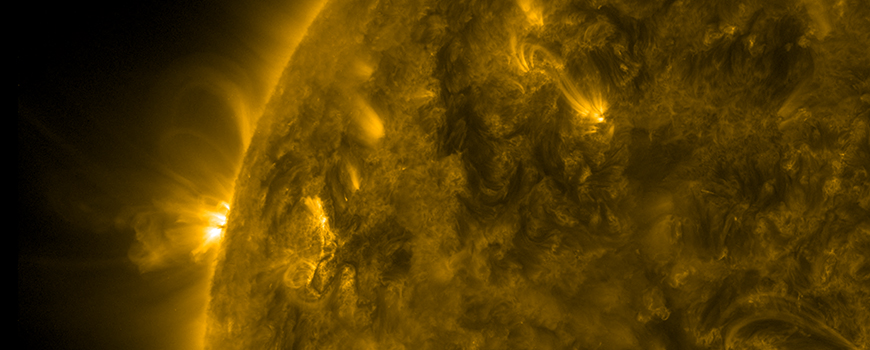Global S&T Development Trend Analysis Platform of Resources and Environment
| Research Highlight: Reduced Energy from the Sun Might Occur by Mid-Century. Now Scientists Know by How Much. | |
| admin | |
| 2018-02-05 | |
| 发布年 | 2018 |
| 语种 | 英语 |
| 国家 | 美国 |
| 领域 | 资源环境 |
| 正文(英文) |  Magnetic loops gyrate above the sun, March 23-24, 2017. Photo: NASA/GSFC/Solar Dynamics Observatory The Sun might emit less radiation by mid-century, giving planet Earth a chance to warm a bit more slowly but not halt the trend of human-induced climate change. The cooldown would be the result of what scientists call a grand minimum, a periodic event during which the Sun’s magnetism diminishes, sunspots form infrequently, and less ultraviolet radiation makes it to the surface of the planet. Scientists believe that the event is triggered at irregular intervals by random fluctuations related to the Sun’s magnetic field. Scientists have used reconstructions based on geological and historical data to attribute a cold period in Europe in the mid-17th Century to such an event, named the “Maunder Minimum.” Temperatures were low enough to freeze the Thames River on a regular basis and freeze the Baltic Sea to such an extent that a Swedish army was able to invade Denmark in 1658 on foot by marching across the sea ice. A team of scientists led by research physicist Dan Lubin at Scripps Institution of Oceanography at the University of California San Diego have created for the first time an estimate of how much dimmer the Sun should be when the next minimum takes place. There is a well-known 11-year cycle in which the Sun’s ultraviolet radiation peaks and declines as a result of sunspot activity. During a grand minimum, Lubin estimates that ultraviolet radiation diminishes an additional seven percent beyond the lowest point of that cycle. His team’s study, “Ultraviolet Flux Decrease Under a Grand Minimum from IUE Short-wavelength Observation of Solar Analogs,” appears in the publication Astrophysical Journal Letters and was funded by the state of California. “Now we have a benchmark from which we can perform better climate model simulations,” Lubin said. “We can therefore have a better idea of how changes in solar UV radiation affect climate change.” Lubin and colleagues David Tytler and Carl Melis of UC San Diego’s Center for Astrophysics and Space Sciences arrived at their estimate of a grand minimum’s intensity by reviewing nearly 20 years of data gathered by the International Ultraviolet Explorer satellite mission. They compared radiation from stars that are analogous to the Sun and identified those that were experiencing minima. The reduced energy from the Sun sets into motion a sequence of events on Earth beginning with a thinning of the stratospheric ozone layer. That thinning in turn changes the temperature structure of the stratosphere, which then changes the dynamics of the lower atmosphere, especially wind and weather patterns. The cooling is not uniform. While areas of Europe chilled during the Maunder Minimum, other areas such as Alaska and southern Greenland warmed correspondingly. Lubin and other scientists predict a significant probability of a near-future grand minimum because the downward sunspot pattern in recent solar cycles resembles the run-ups to past grand minimum events. Despite how much the Maunder Minimum might have affected Earth the last time, Lubin said that an upcoming event would not stop the current trend of planetary warming but might slow it somewhat. The cooling effect of a grand minimum is only a fraction of the warming effect caused by the increasing concentration of carbon dioxide in the atmosphere. After hundreds of thousands of years of CO2 levels never exceeding 300 parts per million in air, the concentration of the greenhouse gas is now over 400 parts per million, continuing a rise that began with the Industrial Revolution. Other researchers have used computer models to estimate what an event similar to a Maunder Minimum, if it were to occur in coming decades, might mean for our current climate, which is now rapidly warming. One such study looked at the climate consequences of a future Maunder Minimum-type grand solar minimum, assuming a total solar irradiance reduced by 0.25 percent over a 50-year period from 2020 to 2070. The study found that after the initial decrease of solar radiation in 2020, globally averaged surface air temperature cooled by up to several tenths of a degree Celsius. By the end of the simulated grand solar minimum, however, the warming in the model with the simulated Maunder Minimum had nearly caught up to the reference simulation. Thus, a main conclusion of the study is that "a future grand solar minimum could slow down but not stop global warming." – Robert Monroe
This story appears in explorations now, Scripps Institution of Oceanography's award-winning ocean and earth science magazine. Sign up to receive our free monthly story roundup.
|
| URL | 查看原文 |
| 来源平台 | Scripps Institution of Oceanography |
| 文献类型 | 新闻 |
| 条目标识符 | http://119.78.100.173/C666/handle/2XK7JSWQ/107452 |
| 专题 | 资源环境科学 |
| 推荐引用方式 GB/T 7714 | admin. Research Highlight: Reduced Energy from the Sun Might Occur by Mid-Century. Now Scientists Know by How Much.. 2018. |
| 条目包含的文件 | 条目无相关文件。 | |||||
| 个性服务 |
| 推荐该条目 |
| 保存到收藏夹 |
| 查看访问统计 |
| 导出为Endnote文件 |
| 谷歌学术 |
| 谷歌学术中相似的文章 |
| [admin]的文章 |
| 百度学术 |
| 百度学术中相似的文章 |
| [admin]的文章 |
| 必应学术 |
| 必应学术中相似的文章 |
| [admin]的文章 |
| 相关权益政策 |
| 暂无数据 |
| 收藏/分享 |
除非特别说明,本系统中所有内容都受版权保护,并保留所有权利。
修改评论